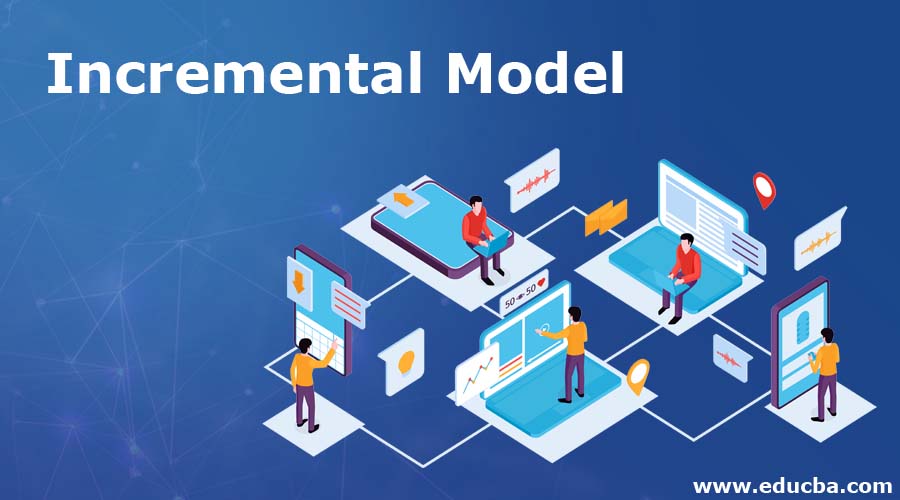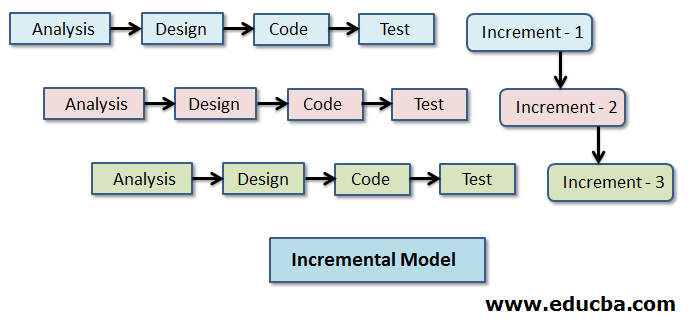
Introduction to Incremental Model
An incremental model is the software development process which is mostly adopted. There are many models in the software development which were developed to achieve different objectives. These models specify the way the software is developed with each stage of iteration and process to be carried to out to implement those stages. The choice of model is completely dependent on the organization and its objective with the software and this choice of model also has a high impact on the testing methodologies as well. Some of the famous models include Agile, Waterfall, Incremental, RAD, Iterative, Spiral etc. In this article, we will look into one such model known as the incremental model.
What is Incremental Model?
Incremental Model is one of the most adopted models of software development process where the software requirement is broken down into many standalone modules in the software development life cycle. Once the modules re the split then incremental development will be carried out in steps covering all the analysis, designing, implementation, carrying out all the required testing or verification and maintenance. In incremental models, each iteration stage is developed and hence each stage will be going through requirements, design, coding and finally the testing modules of the software development life cycle. Functionality developed in each stage will be added on the previously developed functionality and this repeats until the software is fully developed. At each incremental stage there will be though review basing on which the decision on the next stage will be taken out.
Below Diagram illustrates the stages and development of each incremental stage:

You can see that at each stage of incremental development we are going through analysis, design code and test phase and by doing this we are making sure that the various incremental stages are compatible and cumulatively helping in achieving the required objectives from the software.
Importance and characteristics of the Incremental Model
The main importance of the Incremental model is that it divides the software development into submodules and each submodule is developed by following the software development life cycle process SDLC like Analysis, Design, Code, and Test. By doing this model make sure that we are not missing any objective that is expected from the end of the software even though how minor objective it can be. Thus we are achieving 100% objective of the software with this model also since we are testing aggressively after each stage we are making sure of the end software is defect-free and also each stage is compatible with previously developed and future developing stages. Now let’s look into few of the characteristics of the Incremental model and why is such popular.
- The software to be developed will be broken into many stages and hence there will many mini sub-projects for the software.
- The partial systems that will be developed will be combined to get the complete objective of the software.
- Priority will be assigned to each of the stages or requirements and Highest requirement of the software will be tackled first.
- Also after a requirement of the increment is handled and then that the particular increment will be frozen and concentration will be on next increment or requirements.
- At any given time the plan will be laid out only for the existing increment without any long terms plans. So the complete focus will be on the requirement that is being worked upon.
- Each increments versions are developed following the analysis, design, code and test phase and also each incremental version is usually developed by following the iterative waterfall model. These versions can be developed using other models as well.
Phases of Incremental Model
Let us look at each stage in each incremental phase development. Let’s imagine that we are developing second phase and first phase is already developed and 100% working
| Phase in Each Increment | Description |
| Requirement Analysis | Complete the analysis is performed on the requirement and how to make sure that this requirement will be compatible to previously developed |
| Design | Once the requirement for this particular increment i understood and clear then design will be drafted on how to implement and archive this requirement. |
| Code | Now the coding is performed in accordance to achieve the purpose of the requirements. All the coding standards will be followed without any defaults and unnecessary hard codes |
| Test | This is the last in the incremental phase where aggressive testing is performed on the developed code and defects are reported and resolved |
Let’s see when to use the requirement model approach with below bullet points:
- The Requirements should be known clearly and understood, when there is a demand for the early release of the product is there, when there are high-risk features and requirement goals are present in the objective of the software.
- This kind of methodologies are mainly followed by-product based companies as the defects risk in the developed software are quite minimum and also used in developing software in web applications.
- This model is also preferred when the project has lengthy development schedules.
- Also if the development is adopting new technology in the software development then also this method is preferred as the developers are new to the technology
Advantages of the Incremental Model
Lets see few of the advantages of this particular model.
- Since the object will be divided into incremental stages, it will be made sure that 100% requirements are achieved and 100% objective of the software.
- Since there is testing at each incremental phase there will be multiple testings for the software and more the testing better the result and fewer defects.
- By adopting this approach we can lower the initial delivery cost.
- This model is flexible and incurs lest cost when there is a change in the requirement or the scope.
- The user or the customer can provide feedback on each stage so work effort will be valued and sudden changes in the requirement can be prevented.
- Compared to the other model this model is tend to be cheaper on the pockets of the user.
- By following this models errors can be identified quiet easily
Conclusion
Thus we have many models with which we can develop software and achieve the required objective. We have seen about once such model called as Incremental Model with it’s characteristics, application and advantages. The main application whether we use this model is where we have clear understanding of requirement and 100% objective of the software is expected.
Recommended Articles
This is a guide to Incremental Model. Here we discuss the Importance and characteristics of the Incremental Model and its Phases along with advantages. You can also go through our suggested articles to learn more –

